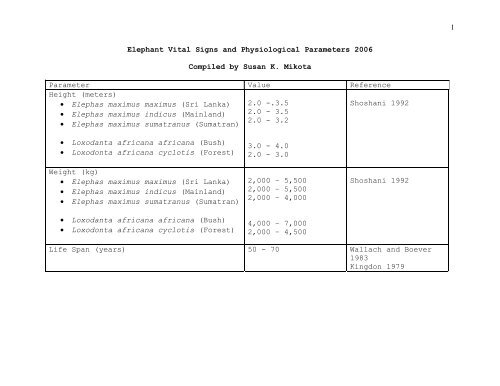Vital Signs and Physiological Values for Elephants - Elephant Care ...
Vital Signs and Physiological Values for Elephants - Elephant Care ...
Vital Signs and Physiological Values for Elephants - Elephant Care ...
Create successful ePaper yourself
Turn your PDF publications into a flip-book with our unique Google optimized e-Paper software.
1<strong>Elephant</strong> <strong>Vital</strong> <strong>Signs</strong> <strong>and</strong> <strong>Physiological</strong> Parameters 2006Compiled by Susan K. MikotaParameter Value ReferenceHeight (meters)• Elephas maximus maximus (Sri Lanka) 2.0 -.3.5Shoshani 1992• Elephas maximus indicus (Mainl<strong>and</strong>) 2.0 - 3.52.0 - 3.2• Elephas maximus sumatranus (Sumatran)• Loxodanta africana africana (Bush)• Loxodonta africana cyclotis (Forest)Weight (kg)• Elephas maximus maximus (Sri Lanka)• Elephas maximus indicus (Mainl<strong>and</strong>)• Elephas maximus sumatranus (Sumatran)• Loxodanta africana africana (Bush)• Loxodonta africana cyclotis (Forest)3.0 - 4.02.0 - 3.02,000 – 5,5002,000 – 5,5002,000 – 4,0004,000 – 7,0002,000 – 4,500Shoshani 1992Life Span (years) 50 - 70 Wallach <strong>and</strong> Boever1983Kingdon 1979
2Blood volume (% of body weight) 3.5 (n=1) Shoshani 1982Chromosome number 56 Hunger<strong>for</strong>d 1966Sakthikumar 1990Suwattana 2000Dental <strong>for</strong>mula I 1/0, C 0/0,Shoshani 1994PM 3/3, M 3/3Total = 26Formula to estimate body weightWeight (kg) = 18.0 Hile 1997(not accurate <strong>for</strong> young elephants)(heart girth in cm)– 3336.Skin thickness (cm) 1.9 - 3.2 Kock 1993Vertebral <strong>for</strong>mulaRectal temperatureHeart rate(beats per minute)C-7, T-19, L-3, S-5,Cd –27;Total # bones 28236 - 37˚ C97.5 - 99˚ F25 - 30 (st<strong>and</strong>ing)72 - 98 (lateralrecumbency)Shoshani 1982Elder 1975Kock 1993Buss 1965Brattstrom 1963Kock 1993Respiratory rate(breaths per minute)4 -12 Schmitt 2003
3Trunk capacity (liters) adult Asian 8.5 Shoshani 1992Urine volume/24 hr (liters/day)25-53Dutta, 2003Cheeran 2002Benedict 1936Simon 1958,1959Average volume / urination (liters)max5.510.58Benedict 1936Frequency of urination/24 hr 5-10 Benedict 1936Simon 1959Fecal production (kg/day) ~110 Dutta, 2003Defecations/day AsianBoluses/defecation AsianWt/bolus Asian (kg)Defecation rate (h/defecation) AfricanWt/defecation African adult (kg)Total dung/24h African,adult femaleSystolic blood pressure (st<strong>and</strong>ing)(mm Hg)Diastolic blood pressure (st<strong>and</strong>ing)(mm Hg)Mean blood pressure (st<strong>and</strong>ing)(mm Hg)(Note that blood pressure increases whenelephants are in lateral recumbency)Arterial PO 2 (st<strong>and</strong>ing)(mm Hg)References12-205-81-2.51.41-1.9110.36100 kg178.6 ± 2.94(n = 7 Asian <strong>and</strong> 8African elephants)118.7 ± 3.10(n = 7 Asian <strong>and</strong> 8African elephants)144.6 ± 2.90(n=7 Asian <strong>and</strong> 8African elephants)96.2 ± 1.55(n=7 Asian <strong>and</strong> 8African elephants)Cheeran 2002Coe 1972Honeyman 1992Honeyman 1992Honeyman 1992Honeyman 1992
4Benedict, F.G., 1936. The physiology of the elephant. Carnegie Institution of Washington,Washington, p 200.Brattstrom, B.H., Stabile, A.J., Williams, F.R., Des Lauiers, J. <strong>and</strong> Pope, D. 1963. Bodytemperature of Indian elephants. Journal of Mammalogy 44(2):282-283.Buss, I.O. <strong>and</strong> Wallner, A. 1965. Body temperature of the African elephant. Journal ofMammalogy 46(1):104-107.Cheeran, J.V. 2002. <strong>Elephant</strong> facts. Journal of Indian Veterinary Association Kerala7(3):12-14.Coe, M. 1972. Defaecation by African elephants (Loxodonta africana africana(Blumenbach)). East African Wildlife Journal 10:165-174.Dutta, D., 2003. Physiology of elephant. In Das,D. (Editor). Healthcare, Breeding <strong>and</strong>Management of Asian <strong><strong>Elephant</strong>s</strong>.New Delhi Project <strong>Elephant</strong>. Govt. of India, pp. 17-22.Elder, W.H. <strong>and</strong> Rodgers, D.H. 1975. Body temperature in the African elephant as relatedto ambient temperature. Mammalia 39:395-399.
5Hile, E.M., Hintz, H.F., <strong>and</strong> Hollis, N. 1997. Predicting body weight from bodymeasurements in Asian elephants (Elephas maximus). Journal of Zoo <strong>and</strong> Wildlife Medicine28(4):424-427.Honeyman, V.L., Pettifer, G. R. <strong>and</strong> Dyson, D.H. 1992. Arterial blood pressure <strong>and</strong> bloodgas values in normal st<strong>and</strong>ing <strong>and</strong> laterally recumbent African (Loxodonta africana) <strong>and</strong>Asian (Elephas maximus) elephants. Journal of Zoo <strong>and</strong> Wildlife Medicine 23(2):205-210.Hunger<strong>for</strong>d, D.A., Ch<strong>and</strong>ra, H.S., Snyder, R.L. <strong>and</strong> Ulmer, F.A. 1966. Chromosomes of threeelephants, two Asian (Elephas maximus) <strong>and</strong> one African (Loxodonta africana). Cytogenetics5(3):243-246.Kingdon, J., 1979. East African mammals. An atlas of evolution in Africa III. Largemammals.Kock, M.D., Martin, R.B., <strong>and</strong> Kock, N. 1993. Chemical immobilization of free-rangingAfrican elephants (Loxodonta africana) in Zimbabwe, using etorphine (M99) mixed withhyaluronidase, <strong>and</strong> evaluation of biological data collected soon after immobilization.Journal of Zoo <strong>and</strong> Wildlife Medicine 24(1):1-10.
6Sakthikumar, A., Mukundan, G. <strong>and</strong> Raghun<strong>and</strong>anan, K.V., 1992. Chromosome profile of Indianelephants. In Silas,E.G., Nair, M.K., <strong>and</strong> Nirmalan, G. eds. The Asian <strong>Elephant</strong>: Ecology,Biology, Diseases, Conservation <strong>and</strong> Management (Proceedings of the National Symposium onthe Asian <strong>Elephant</strong> held at the Kerala Agricultural University, Trichur, India, January1989).Trichur, India Kerala Agricultural University, pp. 41-42.Sakthikumar, A., Mukundan, G. <strong>and</strong> Raghun<strong>and</strong>anan, K. 1990. Chromosome profile of Indianelephants (Elephas maximus indicus). Indian Journal of Animal Sciences 60(2):175-182.Schmitt, D.L., 2003. Proboscidea (<strong><strong>Elephant</strong>s</strong>). In Fowler, M.E. <strong>and</strong> Miller, R.E. eds. Zoo<strong>and</strong> Wild Animal Medicine. Elsevier Science USA, pp. 541-550.Shoshani, J., 1994. Skeletal <strong>and</strong> other basic anatomical features of elephants. InShoshani, J. <strong>and</strong> Tassy, P. eds. The proboscidea: evolution <strong>and</strong> paleoecology of elephants<strong>and</strong> their relatives. Ox<strong>for</strong>d Ox<strong>for</strong>d University Press, pp. 9-20.Shoshani, J., 1992. Comparing the living elephants. In Shoshani, J. ed. <strong><strong>Elephant</strong>s</strong>.Majestic creatures of the wild. Emmaus, Pennsylvania Rodale Press, pp. 36-51.
7Shoshani, J., Alder, R., Andrews, K., Baccala ,M.J., Barbish, A., Barry, S., Battiata,R., Bedore, M.P., Berbenchuk, S.A., Bielaczyc, R., Booth, G., Bozarth, N., Bulgarelli,M.A., Church, I., Cosgriff, J.W.Jr., Crowe, H., DeFauw, S.L., Denes, L., Efthyvoulidis,E., Ekstrom, M., Engelhard, J.G., English, P., Fairchild, D.Jr., Fisher, C., Frahm, K.,Frederick, D., Fried, J., Gaskins, T., Gatt, J., Gentles, W., Goshgarian, H.G.,Grabowski, S., Haase, D., Hajj, K., Hall, G., Hawkins, D., Heberer, C., Helinski, A.,Henry, S.R., Heyka, C., Hurt, M., Kemppainen, M., Kendra, C., Koenig, J., Konarske, P.,Konwinski, S., Kopacz, S., Lakits, V.T., Jr., Lash, .S., Laughlin, D.C., Meyers, S.,Mizeres, N.J., Morehead, K.M., Muraski, A., Murphy, S., Niebala, J., Overbeck, G.,Powitz, R., Rafols, J.A., Raymer, S.L., Rezzonica, L., Rossmoore, H.W., Sabo, D.,Schwikert, P.J., Shy, E., Skoney, J., Smith, D., Spodarek, K.L., Sujdak, P.J., Tarrant,T., Thielman, R., Tisch, F., Wolowicz, L., Williams, J. <strong>and</strong> Yehiel, D. 1982. On thedissection of a female Asian elephant (Elephas maximus maximus Linnaeus, 1758) <strong>and</strong> datafrom other elephants. <strong>Elephant</strong> 2(1):3-93.Simon, K.J. 1959. Further studies on the urine of elephants. Indian Veterinary Journal36:209-212.
8Simon, K.J. 1958. A preliminary study of the urine of elephants. Indian VeterinaryJournal 35:345.Suwattana, D., Koykul, W., Mahasawangkul, S., Kanchanapangka, S., Joerg, H., <strong>and</strong>Stranzinger, G. 2000. The GTG-b<strong>and</strong>ed karyotype <strong>and</strong> telomere FISH in Asian elephants(Elephas maximus). Veterinarni Medicina 45:10-11.Wallach, J.D. <strong>and</strong> Boever, W.J., 1983. Perissodactyla (equids, tapirs, rhinos),Proboscidae (elephants), <strong>and</strong> Hippopotamidae (hippopotamus). In Wallach, J.D. <strong>and</strong> Boever,W.J.eds. Diseases of exotic animals. Philadelphia W.B. Saunders Company, pp. 761-829.
















